The Roadmap for Green Development of Western China
China has made some remarkable achievements in sustainable development, but the constant deterioration of the overall trend of the environment has not yet been effectively curbed. To achieve the goal of sustainable development, we must first ensure coordination and coherence of national development goals in different areas and adhere to green development road. To achieve the objectives related to green development, and to clarify the direction of green development in the next 20 years, a road map is needed to guide and coordinate the process.



